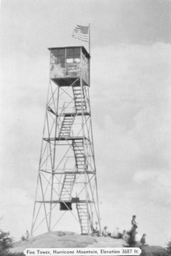Tower History
A Clear View In All Directions – Fire observers were assigned to a lookout station on the summit of Hurricane Mountain beginning in 1910. There was not a structure for the observers because the bald summit had a clear view in all directions. However, State workers strung 2.5 miles of telephone wire to the summit for quick communication between spotters and rangers. The mountain’s first observer, Joseph Denton reported three fires his first season. The next year, twenty two fires were reported by observer Matthew Ryan.

Early Years
The 35 foot high steel fire tower with an observation cabin was erected in 1919, along with many others for the State fire service. Observers watched from dawn to dark, spring to fall from the tower “cab” to spot and pin point smoke and fire. They communicated with each other, tower to tower, to fire wardens, and to local volunteer fire companies with hand cranked telephones. The observer lived in a small cabin below the summit. Life on the mountain through all seasons was not easy, so many observers lasted only a year or two.
For over 50 years, observers would make the daily trek from the cabin to the summit to watch for and report signs of fire. However, in 1979 the tower was officially closed and the Environmental Conservation department relied on air surveillance for fire detection.
Closure and Demolition
In 2001, the tower’s future was in jeopardy, as the State recommended removal of the structure and the reclassification of the land as primitive. This sparked a public campaign to save the Hurricane and the St. Regis Fire Towers.
Push for Restoration
Friends groups petitioned the APA with little success but they did not give up. In June of 2007, the Hurricane Tower was listed on the National Register of Historic Places. Finally, in 2010, the State classified the land at the base of the tower as historic, allowing both the Hurricane and St. Regis fire towers to remain standing.
With new landings and stairs, the tower is now open for public access. Currently, efforts are underway to replace the dangerously degraded roof, which is half blown away, and to place interpretive signs at the trailheads and in tower cab.